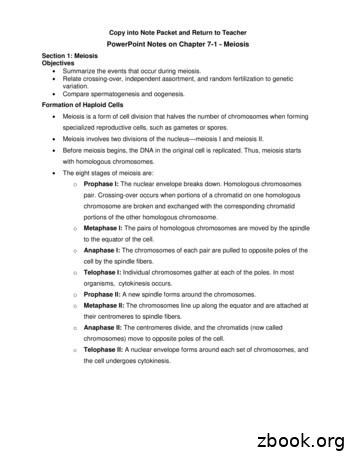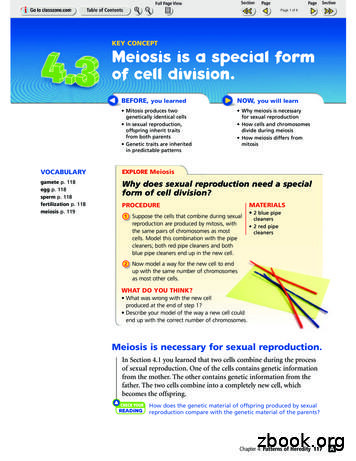Names Date LO: Model Meiosis. SLE: Work Collaboratively. MITOSIS .
DateNamesLO: Model meiosis. SLE: Work collaboratively.MITOSIS & MEIOSIS: On the TableAdapted from 2006 ENSI (Evolution & the Nature of Science Institutes) www.indiana.edu/ ensiwebA. OBJECTIVE: Discover critical differences between mitosis and meiosis, and possible misunderstandings about thetwo processes, by showing key “movie frames” of the key stages in each process on your desk.B. INVENTORY:Working with a partner, create the following chromosomes out of construction paper (making sure thatthey will fit inside of the cells on the sheets provided):12 single (unreplicated) chromosomes, blue12 single (unreplicated) chromosomes, pink4 replicated chromosomes (with sister chromatids), blue4 replicated chromosomes (with sister chromatids), pinkC. ASSUMPTIONS (for the purposes of this exercise):1. The diploid number (2n) of this organism is 2, or one pair;2. Twisting and crossing over are not covered here.D. PROCEDURE:1. Arrange chromosomes on the MITOSIS sheet, showing the essential chromosome arrangements duringmitosis. (You won’t need all the chromosomes for this part.) When you are confident that thearrangements are correct (feel free to check with your instructor!), tape or glue them to the sheet.2. Arrange the remaining chromosomes on the two MEIOSIS sheets, with MEIOSIS I sheet placed above theMEIOSIS II sheet so the arrows flow from sheet to sheet. Remember to show the essential differencesbetween mitosis and meiosis. Be sure to end up with sperm if you are a boy, or an egg with polarbodies if you are a girl. You should use all of the remaining chromosomes for meiosis. When you areconfident that the arrangements are correct (feel free to check with your instructor!), tape or glue themto the sheet.E. REVIEW QUESTIONS:1. Based on your sheets, redraw a cell at each of the following points, showing the chromosomes and spindle. Make surethe blue chromosomes look different in some way from the red ones.Metaphase of MitosisMetaphase I of Meiosis IMetaphase II of Meiosis II2. Is Mitosis more like Meiosis I or Meiosis II? Briefly explain. Hint: look at the pictures for #1.
3. Assume that each blue chromosome has an allele B, while each pink chromosome has an allele b. What will be thefinal genotypes of the sperm or egg cells at the end of Meiosis II?4. Do the spindles appear to serve a similar function in meiosis as they do in mitosis? Briefly explain.5. List 3 differences between mitosis and meiosis.6. Over evolutionary time, organisms can change their total number of chromosomes. There are advantages to increasingone’s number of chromosomes; for example, you can have more genes in which to encode more proteins that performmore functions. Based on seeing the complicated, intricate movements of the chromosomes during mitosis and meiosis,describe a possible DISadvantage of having “extra” chromosomes.
Names:MEIOSIS IPlace this layout sheet above theMEIOSIS II layout sheet.Place model chromosomes in eachcell according to rules andassumptions on theProcedures sheet.DO NOT WRITE ON THIS SHEETPROPHASE IMETAPHASE IANAPHASE I(TELOPHASE I)(PROPHASE II)
MEIOSIS IIMETAPHASE II(ANAPHASE II)(TELOPHASE II)ORORORORIN MALES:4 SpermIN FEMALES:1 Egg and3 Polar BodiesNUCLEUSYOLK(in cytoplasm)Three Polar BodiesEgg (Ovum)
MITOSISNames:Use it first, placing your modelchromosomes in each cell circleaccording to the rules andassumptions listed on theprocedure sheet.PROPHASEDO NOT WRITE ON THIS SHEETMETAPHASEANAPHASE(TELOPHASE)DAUGHTER CELLS
2. Arrange the remaining chromosomes on the two MEIOSIS sheets, with MEIOSIS I sheet placed above the MEIOSIS II sheet so the arrows flow from sheet to sheet. Remember to show the essential differences between mitosis and meiosis. Be sure to end up with sperm if you are a boy, or an egg with polar bodies if you are a girl.
Cell Division in Sexual Reproduction: Meiosis Meiosis is the mechanism by which eukaryotic cells produce mature sex cells or gametes Meiosis produces four haploid cells (gametes) Meiosis involves partition of both cytoplasmic and nuclear structures Meiosis consists of Meiosis I and Meiosis II. Both phases are followed by .
Meiosis is a form of cell division that halves the number of chromosomes when forming specialized reproductive cells, such as gametes or spores. Meiosis involves two divisions of the nucleus—meiosis I and meiosis II. Before meiosis begins, the DNA in the original cell is replicated. Thus, meiosis starts with homologous chromosomes.
During meiosis, a single cell goes through two cell divisions—meiosis I and meiosis II. Meiosis takes place only in the reproductive tissues of an organism. Cells divide twice during meiosis. Before meiosis begins, the chromosomes of the parent cell are copied. A cell that is ready to divide contains two copies of each
TAKING NOTES Draw a Venn diagram like the one below to summarize the similarities and differences between meiosis I and meiosis II. chromo-somes condense divides homologous chromosomes divides sister chromatids Meiosis I Meiosis II 6.2 Process of Meiosis KEY CONCEPT During meiosis, diploid ce
I II III IV A DNA Replication Mitosis Meiosis Fertilisation B DNA Replication Meiosis 1 Meiosis 2 Fertilisation C Fertilisation Meiosis Mitosis DNA Replication D Mitosis Meiosis 1 Meiosis 2 DNA Replication 4.4 In analysing the number of different bases in a DNA sample, the following result would be consistent with the base-pairing rules: .
Meiosis is a process in which the number of chromosomes per cell is cut in half through the separation of homologous chromosomes in a diploid cell. Meiosis usually involves two distinct divisions, called meiosis I and meiosis II. By the end of meiosis II, the diploid cell becomes four haploid cells.File Size: 796KB
II. Process of Meiosis (6.2) A. Cells go through _ rounds of division in meiosis 1. Meiosis produces _ haploid cells from one diploid cell 2. Process involves two rounds of _ _- Meiosis I and Meiosis II. B. Homologous Chromosomes and sister Chromatids 1.
Now that you've seen how meiosis works, let's review two key differ-ences between the processes of meiosis and mitosis. Meiosis has two cell divisions. Mitosis has only one cell division. Meiosis results in haploid cells. Mitosis results in diploid cells. On the diagram above, circle the part in the process of meiosis























